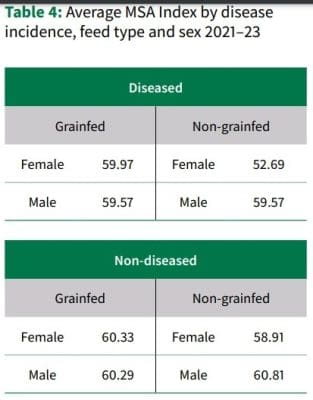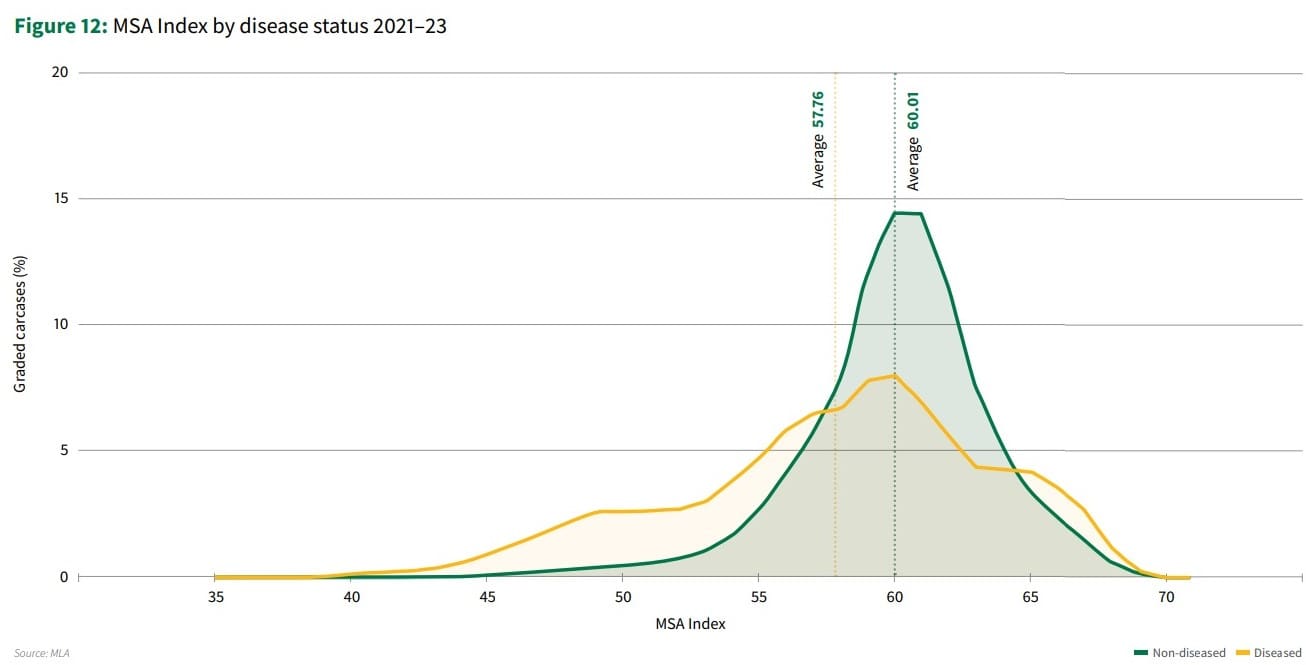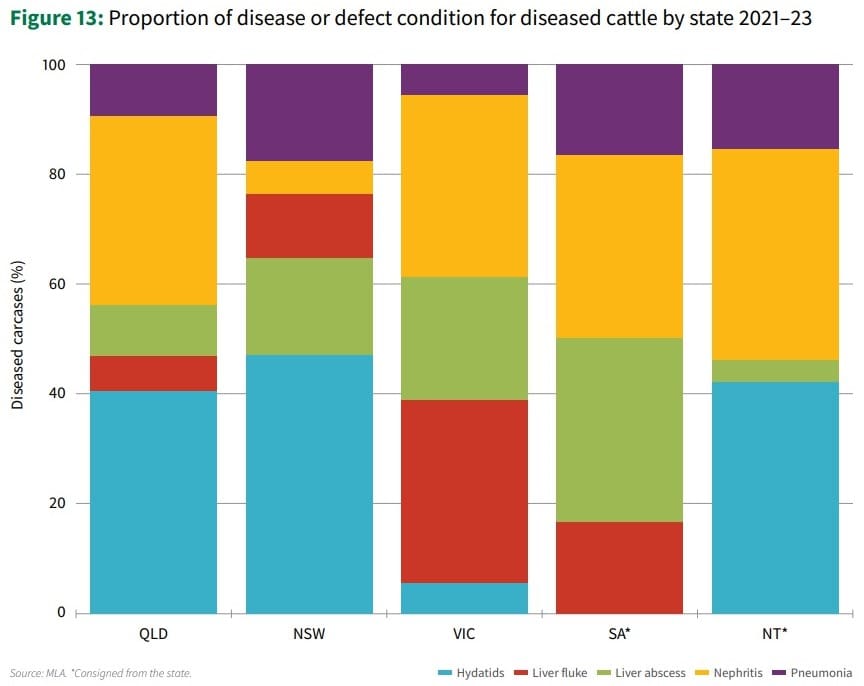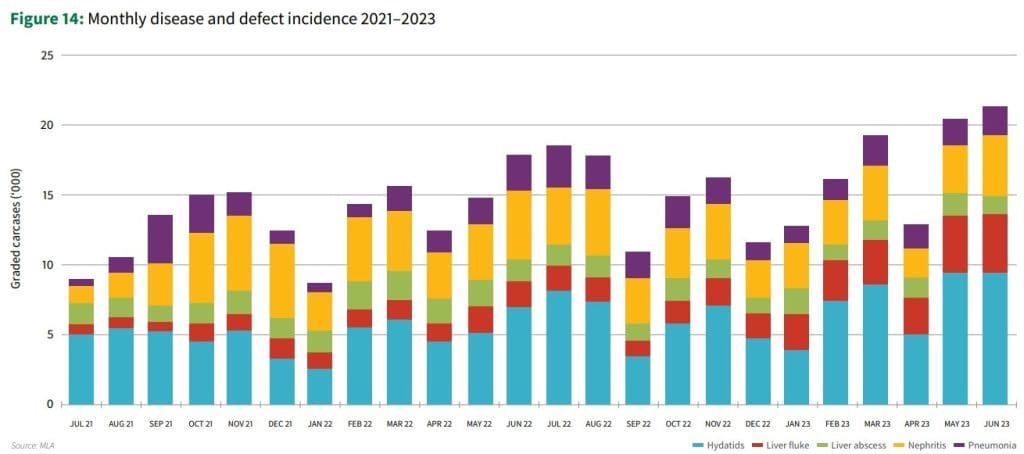THE effect that sub-clinical disease and parasite challenge has on eating quality performance is clearly illustrated in results from the latest Australian Beef Eating Quality Insights Report released this week.
Published every two years, the 2022-23 report (click here to access) released on Tuesday captures the past two years of MSA performance data, including eating quality trends.
Data is broken down by state and a range of other criteria.
MSA graded cattle comprised 54pc of all Australian slaughter animals for the 2022–23 financial year, using data collected by MSA graders, along with additional data from sources such as the National Livestock Reporting Service and further information such as animal disease and defects.
Five large northern and southern processing plants contributed animal disease data for comparison. Introduced for the first time in the previous report was a new assessment of disease impact on performance, made available through MSA measuring the impact of sub-clinical diseases and parasite challenges such as nephritis, hydatids, liver fluke, liver abscess and pneumonia on eating quality scores.
Based on data from the five MSA processors, 280,000 disease and parasite-free cattle (green line in graph above) had an average MSA EQ Index of more than 60, compared to 90,000 impacted cattle (yellow line) with an average index score of 57.76.
Gender, feed effect
 Data for disease status, feed type and gender shows male disease or parasite-impacted cattle were 0.7 and 1.2 MSA Index points lower than non-diseased, for grainfed and non-grainfed respectively.
Data for disease status, feed type and gender shows male disease or parasite-impacted cattle were 0.7 and 1.2 MSA Index points lower than non-diseased, for grainfed and non-grainfed respectively.
Disease-impacted female cattle were 0.4 MSA Index points lower for grainfed, and 6.2 points lower for non-grainfed.
The large difference for non-grainfed female cattle may be attributed to a greater proportion of older cattle consigned for slaughter as cull cows, therefore showing a greater incidence of liver fluke and hydatids, evidenced as active or inactive cases of the disease at inspection, the report said.
State breakdown
Based on the available data, 78pc of grainfed MSA carcases assessed in Queensland were classified as disease-free compared to 41pc of non-grainfed cattle. Nephritis was the prominent health condition for Queensland grainfed cattle (7pc) while hydatids was the prominent health condition for non-grainfed (48pc).
In New South Wales, 90pc of grainfed cattle were non-diseased compared to 88pc of grassfed. For grainfed, the most prominent health condition was pneumonia (4pc), while for non-grainfed carcases, the highest disease incidence was hydatids (6pc).
In Victoria, 99pc of grainfed cattle were disease-free, and 87pc of non-grainfed. The main health condition in Victoria for non-grainfed cattle was nephritis (5pc).
No processing plants in South Australia or Western Australia contributed defect data for the report, but the entries in the graph published below are for cattle from those states processed in eastern states.
Production cost impact
Average costs of potential lost opportunities by disease or defect condition per carcase were calculated, with hydatids displaying the highest cost, at $5.97 per carcase. Liver fluke cost impact averaged $4.14/carcase, liver abscess $4.33, pneumonia $3.75 and nephritis 62c/head. Compromised carcase weight was not included in the lost opportunity calculation.
Figures on lost opportunity were derived from the MLA Co-products monthly report based on offal value from processors. The values were calculated by offal weight (averaged for carcase weight) multiplied by lost opportunity cost for disease incidence and averaged across the total number of cattle.
Hydatids incidence growing
The prevalence of hydatids varies across Australia. Tasmania and South Australia had little or no hydatid disease while other states tended to have regions often associated with poor control in farm dogs, the presence of wild dogs (carriers of hydatids), and to a lesser extent, foxes and other at risk intermediate hosts such as kangaroos or pigs.
Based on the disease and defect information, which represents approximately 20pc of the national slaughter, the incidence of hydatids in Queensland has increased from 11pc to 13pc and NSW from 5pc to 8pc within this most recent two-year period (2021–2023), compared to the previous period covered by the 2019–2021 report.
A more detailed report on the financial and production impact that hydatids is having on the Australian beef industry is expected in coming months.
Click here to access full report.



